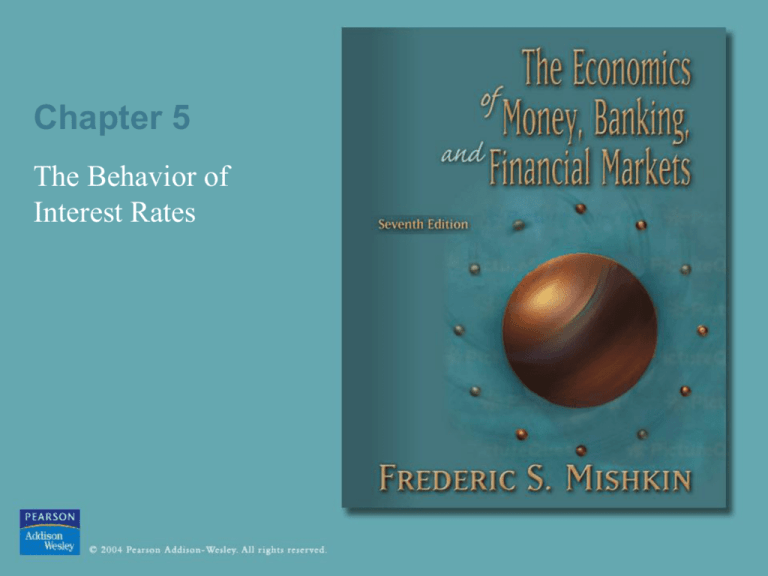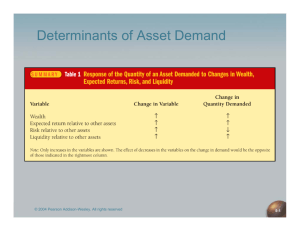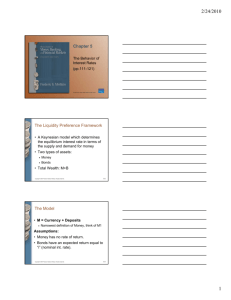
Chapter 5
The Behavior of
Interest Rates
Interest rates are negatively related
to the price of bonds
• If we can explain why bond prices change,
we can explain why interest rate fluctuate.
• To derive a demand curve of assets, like
money or bonds, we use the theory of asset
demand.
© 2004 Pearson Addison-Wesley. All rights reserved
5-2
Determinants of Asset Demand
1. Wealth: the total resources owned by the
individuals.
2. Expected return: on one asset relative to
alternative assets
3. Risk: on one asset relative to alternative assets
4. Liquidity: relative to alternative assets
© 2004 Pearson Addison-Wesley. All rights reserved
5-3
Determinants of Asset Demand
© 2004 Pearson Addison-Wesley. All rights reserved
5-4
Derivation of Bond Demand Curve
e
i = RET =
(F – P)
P
Point A:
P = $950
($1000 – $950)
i=
$950
= 0.053 = 5.3%
d
B = $100 billion
© 2004 Pearson Addison-Wesley. All rights reserved
5-5
Derivation of Bond Demand Curve
Point B:
P = $900
i=
($1000 – $900)
$900
= 0.111 = 11.1%
d
B = $200 billion
d
Point C: P = $850, i = 17.6% B = $300 billion
d
Point D: P = $800, i = 25.0% B = $400 billion
d
Point E: P = $750, i = 33.0% B = $500 billion
d
Demand Curve is B in Figure 1 which connects points A, B, C, D, E.
Has usual downward slope
© 2004 Pearson Addison-Wesley. All rights reserved
5-6
Derivation of Bond Supply Curve
Point F:
s
P = $750, i = 33.0%, B = $100 billion
s
Point G: P = $800, i = 25.0%, B = $200 billion
s
Point C: P = $850, i = 17.6%, B = $300 billion
s
Point H: P = $900, i = 11.1%, B = $400 billion
Point I:
s
P = $950, i = 5.3%, B = $500 billion
s
Supply Curve is B that connects points F, G, C, H, I, and has upward
slope
© 2004 Pearson Addison-Wesley. All rights reserved
5-7
Supply and
Demand
Analysis of
the Bond
Market
Market Equilibrium
d
s
1. Occurs when B = B , at P* =
$850, i* = 17.6%
s
2. When P = $950, i = 5.3%, B >
d
B (excess supply): P to P*, i
to i*
d
3. When P = $750, i = 33.0, B >
s
B (excess demand): P to P*,
i to i*
© 2004 Pearson Addison-Wesley. All rights reserved
5-8
Loanable Funds Terminology
1. Demand for bonds =
supply of loanable
funds
2. Supply of bonds =
demand for loanable
funds
© 2004 Pearson Addison-Wesley. All rights reserved
5-9
Changes in Equilibrium Interest Rates
• Make the distinction between:
movement along a demand (or supply)
curve and shifts in a demand (or supply)
curve.
© 2004 Pearson Addison-Wesley. All rights reserved
5-10
Shifts in the Bond Demand Curve
© 2004 Pearson Addison-Wesley. All rights reserved
5-11
Factors that Shift the Bond Demand Curve
1. Wealth
A. Economy grows, wealth , Bd , Bd shifts out to right
2. Expected Return (expected i, and expected π)
A. i in future, Re for long-term bonds , Bd shifts out to
right
B. e , expected return of real assets (physical assets) ,
relative Re , Bd shifts out to right
C. Expected return of other assets (ex. stocks) , Bd , Bd
shifts out to right
3. Risk
A. Risk of bonds(volatile) , Bd , Bd shifts out to right
B. Risk of other assets , Bd , Bd shifts out to right
4. Liquidity (more people started trading bonds)
A. Liquidity of Bonds , Bd , Bd shifts out to right
© 2004 Pearson
Addison-Wesley. All rights
B. Liquidity
of reserved
other assets , Bd , Bd shifts out to right
5-12
Factors
that Shift
Demand
Curve for
Bonds
© 2004 Pearson Addison-Wesley. All rights reserved
5-13
Shifts in the Bond Supply Curve
1. Profitability of
Investment
Opportunities
Business cycle
expansion,
investment
opportunities ,
Bs , Bs shifts out
to right
2. Expected Inflation
e , Bs , Bs
shifts out to right
3. Government
Activities
Deficits , Bs , Bs
shifts out to right
5-14
Factors that Shift the Bond Demand Curve
1. Profitability of Investment Opportunities
Business cycle expansion, investment opportunities ,
Bs , Bs shifts out to right
2. Expected Inflation
e , the real cost of borrowing , Bs , Bs shifts out to
right
3. Government Activities
Deficits , Bs , Bs shifts out to right
© 2004 Pearson Addison-Wesley. All rights reserved
5-15
Factors
that Shift
Supply
Curve for
Bonds
© 2004 Pearson Addison-Wesley. All rights reserved
5-16
Changes in e: the Fisher Effect
If e
1. Relative RETe ,
Bd shifts in to
left
2. Bs , Bs shifts
out to right
3. P , i
5-17
Evidence on the Fisher Effect
in the United States
© 2004 Pearson Addison-Wesley. All rights reserved
5-18
Business Cycle Expansion
1. Wealth , Bd ,
Bd shifts out to
right
2. Investment ,
Bs , Bs shifts
out to right
3. If Bs shifts
more than Bd
then P , i
5-19
Evidence on Business Cycles
and Interest Rates
© 2004 Pearson Addison-Wesley. All rights reserved
5-20
Relation of Liquidity Preference
Framework to Loanable Funds
Keynes’s Major Assumption
Two Categories of Assets in Wealth
Money
Bonds
1. Thus:
Ms + Bs = Wealth
2. Budget Constraint:
Bd + Md = Wealth
3. Therefore:
Ms + Bs = Bd + Md
4. Subtracting Md and Bs from both sides:
Ms – Md = Bd – Bs
Money Market Equilibrium
5. Occurs when Md = Ms
6. Then Md – Ms = 0 which implies that Bd – Bs = 0, so that Bd = Bs and
bond market is also in equilibrium (Walras Law).
© 2004 Pearson Addison-Wesley. All rights reserved
5-21
1. Equating supply and demand for bonds as
in loanable funds framework is equivalent
to equating supply and demand for money
as in liquidity preference framework
2. Two frameworks are closely linked, but
differ in practice because liquidity
preference assumes only two assets, money
and bonds, and ignores effects on interest
rates from changes in expected returns on
real assets (automobiles and houses)
© 2004 Pearson Addison-Wesley. All rights reserved
5-22
Liquidity Preference Analysis
Derivation of Demand Curve
1. Keynes assumed money has i = 0
2. As i , relative RETe on money (equivalently, opportunity cost
of money ) Md
3. Demand curve for money has usual downward slope
Derivation of Supply curve
1. Assume that central bank controls Ms and it is a fixed amount
2. Ms curve is vertical line
Market Equilibrium
1. Occurs when Md = Ms, at i* = 15%
2. If i = 25%, Ms > Md (excess supply): Price of bonds , i to i*
= 15%
3. If i =5%, Md > Ms (excess demand): Price of bonds , i to
i* = 15%
© 2004 Pearson Addison-Wesley. All rights reserved
5-23
Money
Market
Equilibrium
© 2004 Pearson Addison-Wesley. All rights reserved
5-24
Shifts in the Demand for Money
• Income Effect
Economy expands, income rises, wealth increases,
people will hold more money as a store of value
and for transactions
• Price-Level Effect
people care about the amount of money they hold
in real terms. When the price level rises, the same
nominal quantity of money is no longer as
valuable
© 2004 Pearson Addison-Wesley. All rights reserved
5-25
Rise in Income or the Price Level
1. Income , Md , Md
shifts out to right
2. Ms unchanged
3. i* rises from i1 to i2
© 2004 Pearson Addison-Wesley. All rights reserved
5-26
Shifts in the Supply of Money
• Assume that supply of money is
completely controlled by the central
bank
© 2004 Pearson Addison-Wesley. All rights reserved
5-27
Rise in Money Supply
1. Ms , Ms shifts out to right
2. Md unchanged
3. i* falls from i1 to i2
© 2004 Pearson Addison-Wesley. All rights reserved
5-28
5-29
Money and Interest Rates (Application, p.112)
Effects of money on interest rates
1. Liquidity Effect (everything else remaining equal)
Ms , Ms shifts right, i
2. Income Effect
Ms , Income , Md , Md shifts right, i
3. Price Level Effect
Ms , Price level , Md , Md shifts right, i
4. Expected Inflation Effect (a higher rate of money supply growth)
Ms , e , Bd , Bs , Fisher effect, i
Effect of higher rate of money growth on interest rates is
ambiguous
1. Because income, price level and expected inflation effects work
in opposite direction of liquidity effect
© 2004 Pearson Addison-Wesley. All rights reserved
5-30
Does
Higher
Money
Growth
Lower
Interest
Rates?
5-31
Evidence on Money Growth
and Interest Rates
© 2004 Pearson Addison-Wesley. All rights reserved
5-32








